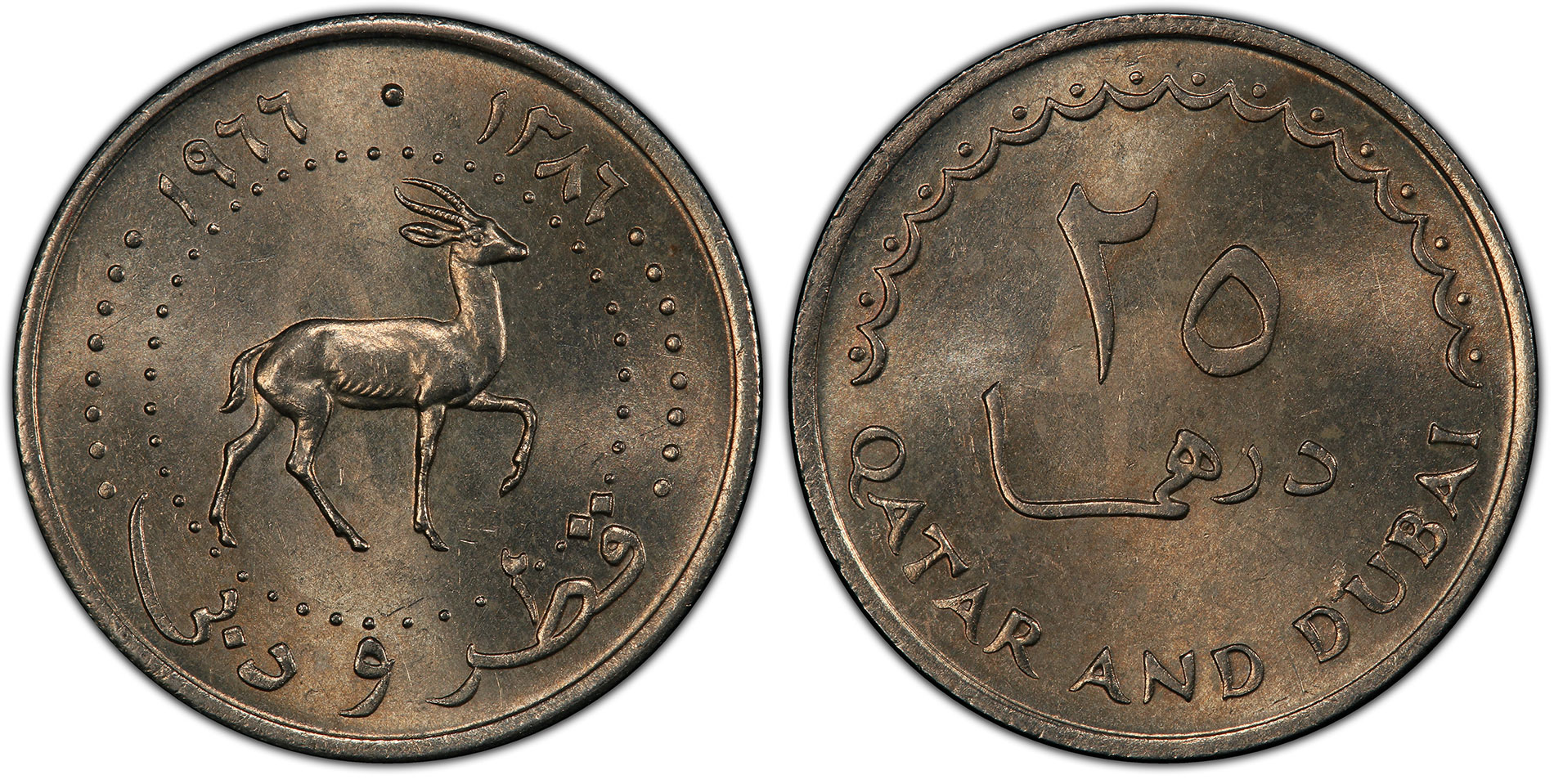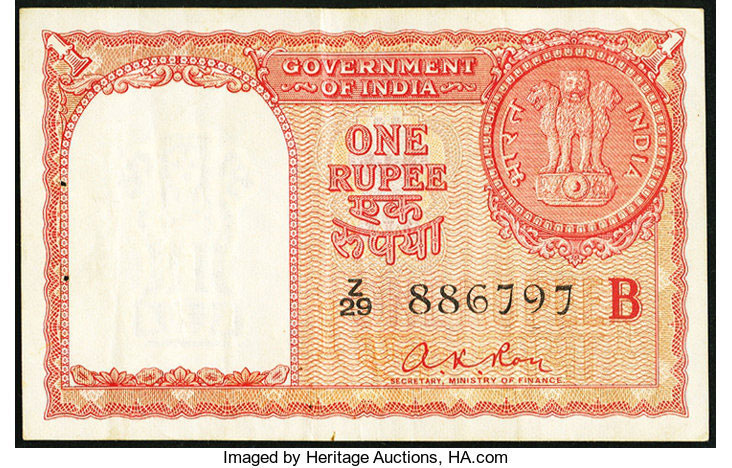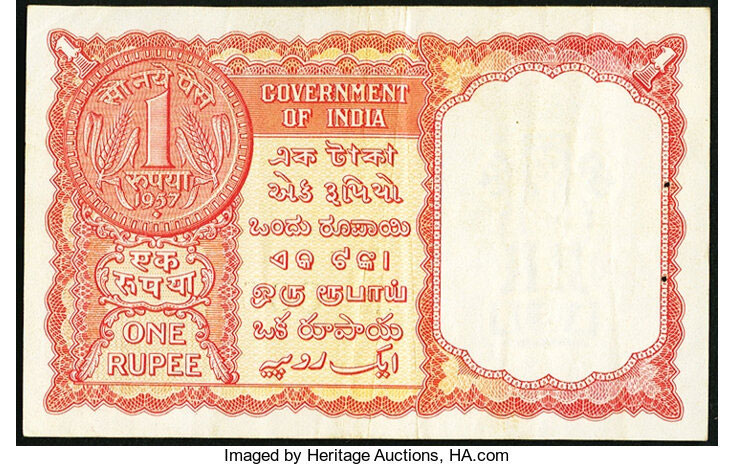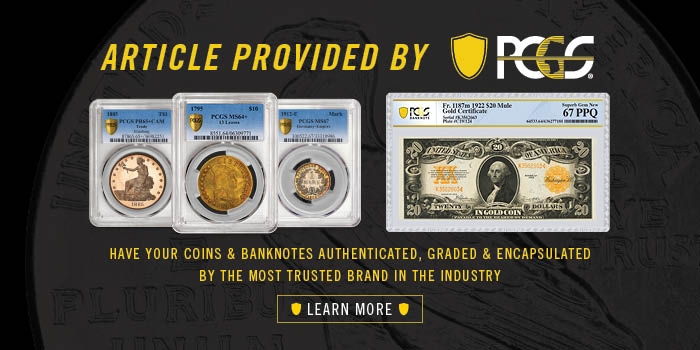By Jay Turner for PCGS ……

Qatar & Dubai AH1386-1966 25 Dirhams, PCGS MS64. Images courtesy PCGS
The Gulf Emirate States are an amazing and rich area of the world, with the history of this region stretching back thousands of years.
Prior to the discovery of oil there and the wealth from it, what today is the United Arab Emirates and Qatar were a bunch of independent Emirate States under an informal British protectorate, including a foreign monetary system. Due to changes made by other countries that controlled their currency, for a short seven years Dubai and Qatar issued their own joint coinage and currency system.
Under the British-ruled Trucial States, the area of the Gulf States–which included states that would later form the United Arab Emirates, Kuwait, Oman, Bahrain, and Qatar–the British formed a monetary policy that placed these states under the Indian rupee currency.
With Indian independence, the rupee continued to serve as the currency of the Gulf States. Pegged to the British pound at 13-1/3 to one, the rupee was stable and, for some traders, lucrative. Traders in gold would take their precious metal to India to sell it for Indian rupees, then take the Indian currency and trade it for more valuable foreign currency – which they would use to buy more gold and the cycle continued, profiting with each transaction.
This arbitrage became so great that foreign currency reserves in India were strained. As a result, the Indian government created and printed “Gulf Rupees”, a currency on par with the Indian rupee but for exclusive circulation outside the country. On June 6, 1966, the Indian government devalued the Gulf rupee against the Indian rupee.


Front (top) and Back (bottom), India 1957 Gulf 1 Rupee. Note prefix “Z” are Gulf issues. Photos courtesy of Heritage Auctions.
With the creation of the Gulf rupee, some Gulf states had proactively removed themselves from what would be a future economic issue by moving to their own or switching to a different country’s currency. Kuwait and Bahrain issued their own independent dinars pegged to the Indian rupee and thus pegged to the pound. Qatar switched to the Saudi riyal in 1959.
But in 1966, Qatar and Dubai came together to form their own single currency, and on March 21, the Qatar-Dubai Currency Agreement was signed by both countries.

Qatar & Dubai AH1391-1971 10 dirhams – PCGS MS64RB
Under the Qatar Dubai currency, coins were issued in the denominations of One, Five, 10, 25, and 50 dirhams. The coins feature a sand gazelle on the obverse with the date in both lunar Hijri and Common Era dating systems in Arabic with “Qatar and Dubai” in Arabic below. The reverse features the denomination in Arabic and “Qatar and Dubai” in English. The One and 50 Dirhams were issued only in AH1386-1966; the Five and 25 dirhams were issued in both AH1386-1966 and AH1389-1969; and the 10 Dirhams were issued in AH1386-1966 and in AH1391-1971. The One, Five, and 10 Dirhams were issued in bronze and the 25 and 50 Dirhams were issued in copper-nickel.
The coins circulated along with the currency until 1973. The series is easily collectible, with the exception of the AH1391-1971 10 Dirhams, which has a low mintage of only 1,500 struck by the British Royal Mint and can exceed $1,000 USD in Uncirculated condition in the right auction settings.
The death of the joint Qatar-Dubai currency came when Dubai joined other Emirate states in the formation of the United Arab Emirates. Qatar, which was offered membership, turned it down and continued as its own state, issuing its own independent coinage and currency. In 1973, the United Arab Emirates issued its own currency as a united country, Dubai included.
The joint coinage and currency of Qatar and Dubai survives as a historical reminder of the independent Emirates and the need for an independent currency that isn’t subject to another government’s devaluations.
* * *






I have all these currencies available with me… Full collection of Qatar- Dubai and Dubai’s…
I have Dubai and Qate coin